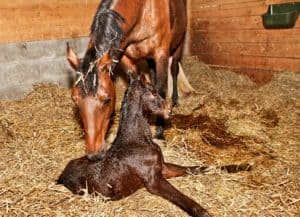Detecting Twins in Horses: Check the Fetal Heartbeats

Detecting Twins
Twin pregnancies occur when mares double ovulate, meaning they release two eggs in the same cycle, Vera said. That happens in about 25% of heat cycles in Thoroughbreds and Warmbloods, although many of those don’t result in twin pregnancies. When they do, veterinarians often identify them through ultrasound checks in the second week of pregnancy and eliminate a twin by pinching it.
Most twin pregnancies, if not reduced to a single pregnancy, result in abortion, stillbirth, or weak and nonviable foals, Vera said.
While transrectal ultrasound can identify twin pregnancies very early during the embryonic stage, this method is less effective at detecting two fetuses once they’ve grown too large. And transabdominal ultrasound (using the ultrasound probe against the abdominal wall) might allow scientists to get a glimpse of a foal—if it’s not hidden behind the mare’s intestines. But to diagnose a twin pregnancy, it’s important to see both foals at the same time, Vera said. Otherwise, only seeing one foal at a time could be confused with seeing the same foal twice
Create a free account with TheHorse.com to view this content.
TheHorse.com is home to thousands of free articles about horse health care. In order to access some of our exclusive free content, you must be signed into TheHorse.com.
Start your free account today!
Already have an account?
and continue reading.

Written by:
Christa Lesté-Lasserre, MA
Related Articles
Stay on top of the most recent Horse Health news with















